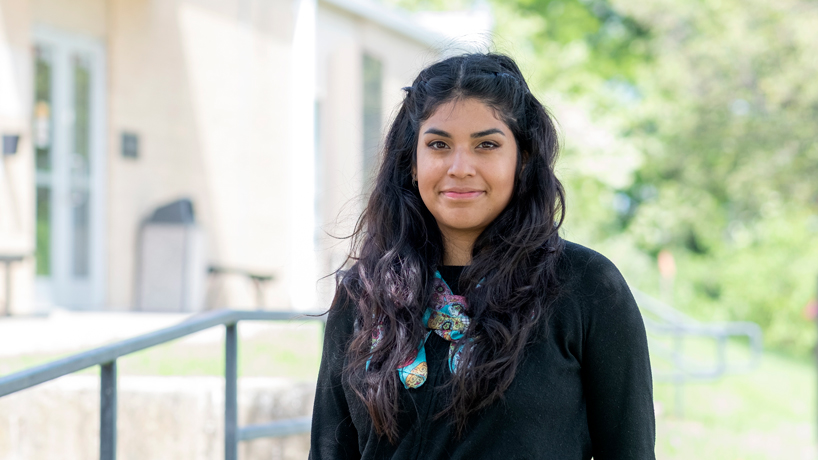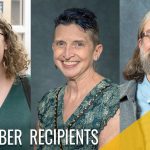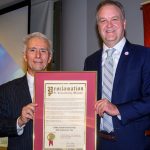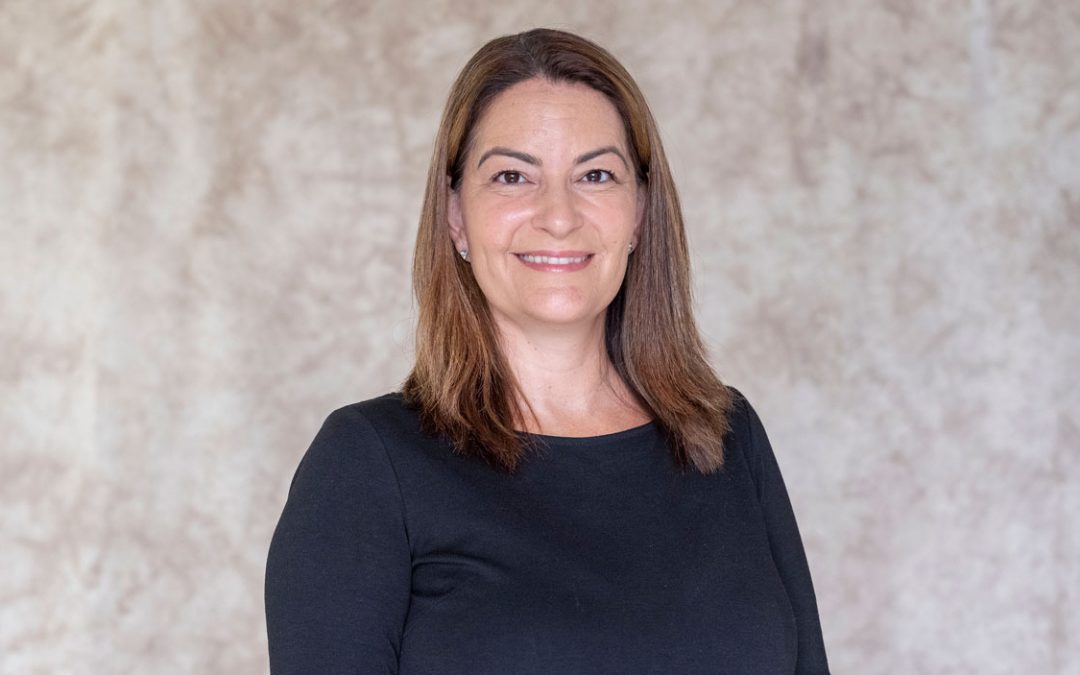
Maribel Ramirez-Bohenkamp came to UMSL to take advantage of its unique Teach in 12 program. Now certified, she is searching for a teaching position and plans to pursue a master’s degree in art education. (Photos by August Jennewein)
Shellby Brannam had only just realized she loved the classroom. Maribel Ramirez-Bohenkamp was managing and teaching classes at Pinot’s Palette after graduating with her bachelor’s degree.
They might have never crossed paths.
But then Jennifer Fisher, assistant teaching professor and coordinator of art education at the University of Missouri–St. Louis, intervened. She drew both women to UMSL and set them upon a trajectory that found them working together to produce an edition of Show Me ART, a bi-annual publication of the Missouri Art Education Association.
Brannam, a BFA graduate, and Ramirez-Bohenkamp, a Teach in 12 certificate graduate, completed their art education studies this semester and will go into the world richer for having worked together on the publication. That couldn’t have happened anywhere but at UMSL.
The magazine is a full-color, professional publication that is mailed to art teachers throughout the state, and Brannam happened to be in the right place at the right time when the Missouri Art Education Association was looking for an editor. She was attending the organization’s 2019 fall conference when a few council members were discussing the vacancy for the upcoming year.
During her time at UMSL, Brannam (far left) was also part of Arts Life, On Site, a new class that aims to help students explore career options in the arts.
They were looking for a member of the organization who was familiar with layout to take on the project. Brannam had been a designer for her high school newspaper and is well versed in Adobe Illustrator and InDesign, so she decided to volunteer for the position.
“I was like, ‘I think I can put one more thing on my already full plate,’” she recalled with a laugh.
Introducing gradual change to the magazine was one of Brannam’s goals after taking over as editor. To that end, she proposed featuring educators’ personal artwork on the covers. The suggestion garnered a positive response from MAEA President Hester Menier and the council members.
“Often times, educators are so focused on our students, which is amazing, but we never find avenues for ourselves to keep working on our art or to showcase our art,” Brannam said. “I wanted to give educators that opportunity again.”
The first issue Brannam produced featured Ramirez-Bohenkamp’s work on the cover, though she didn’t know that would be the case when she agreed to contribute.
“It was a huge surprise for me to even participate in the magazine,” Ramirez-Bohenkamp said. “I had just finished up a live art show called Wall Ball 2020 hosted by Artscope in St. Louis, and after that, Shellby reached out to me and asked if I would like to be featured in the magazine, which I agreed to. I wasn’t necessarily thinking that it was going to be the cover and a spread on my artwork, but that was a very pleasant surprise.”
The cover art was derived from one of Ramirez-Bohenkamp’s acrylic paintings on canvas. It depicts a sugar skull with her own twist. She noted sugar skulls – decorations and designs used in Mexican Day of the Dead celebrations – are traditionally very colorful, while hers uses a more muted color palette with bluish grays, deep reds and white detailing. The piece also includes floral elements, particularly the dahlia flower, and the monarch butterfly.
Ramirez-Bohenkamp’s work often draws upon her Mexican-American heritage and connection to her family. It has been a meaningful link to family members who reside about eight hours away in Kansas.
“When I make these pieces, things from my childhood, I’m trying to keep my identity alive out here in Missouri,” she said. “I don’t really get a lot of exposure to my own Mexican culture in this area as much as I did where I came from in Kansas. It’s making those connections and working through that, moving somewhere different and trying to build and create something with your family in mind.”
The response to the issue was thoroughly positive.
“I received so many compliments from the past editors, our president and educators throughout Missouri, reaching out saying, ‘This looks amazing, I can’t believe what you’ve done,’” Brannam said. “It made me really proud.”
Editing the first issue was a steep learning curve, but Brannam was grateful for the experience. She felt similarly during her time at Lucas Crossing Elementary in Normandy, Missouri, where she completed her final student teaching practicum.
“I got the amazing opportunity that a lot of people don’t get in their practicum,” Brannam said. “I fulfilled being the art teacher by myself. I took on that full-time position while doing my student teaching there. One other student and I were hired at Normandy because they really needed people to fulfill those roles. I saw it as a really great challenge to build as a person.”
It’s an atypical arrangement for a student teaching practicum – one Brannam likened to being “pushed into the deep end.” But it gave her the opportunity to craft her own curriculum and helped her rapidly develop as a teacher.
The other challenge Brannam faced – aside from student teaching without the guidance of a more experienced educator – was the cultural shift from the rural area where she grew up to a more urban environment.
“It was completely different culturally, racially, diversely than what I’ve ever experienced,” she said. “It taught me how to be a better person. It opened my eyes to how you can be a bridge, even though you have to find that common ground in a different way than what you’re used to.”
Brannam started building a bridge by introducing her students to a number of contemporary African American artists and later focused on the work of Kehinde Wiley, known for his paintings of African American subjects in poses mimicking the classical portrait traditions of Europe. The students were tasked with creating their own portraits in Wiley’s style, which resulted in full participation – a significant achievement. She has also worked to include things such as graffiti and mixed media elements into her classes.
After graduation, Brannam will continue working at Lucas Crossing, and Ramirez-Bohenkamp is proactively reaching out to schools and filling out applications. However, both graduates have other goals beyond teaching.
They each plan to pursue master’s degrees and work toward founding nonprofit art organizations. Brannam is interested in studying either educational psychology or art history, and Ramirez-Bohenkamp has decided on art education. They’re still conceptualizing their nonprofits, but Brannam wants to help survivors of sexual assault through art. Ramirez-Bohenkamp hopes to create a space for community-focused art.
Whatever their future endeavors may be, the graduates know UMSL pushed their abilities as artists and educators.
“It was a challenging but very fulfilling time,” Ramirez-Bohenkamp said. “I have learned so much about my own art practices, as well as applying my skill into art education. There have been times where I have felt overwhelmed with the curriculum and criteria, but it has very much let me see clearly what it takes to be a teacher. It’s not an easy job, otherwise more people would want to do it. Even though I’ve gone through a lot of hurdles financially and academically, I’ve pushed myself beyond what I thought was my potential. UMSL was able to bring that to light for me.”















